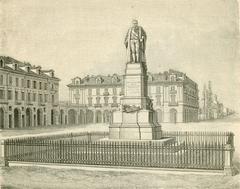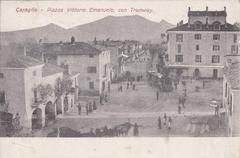
Visiting Piazza Galimberti: Hours, Tickets, and Historical Sites in Cuneo
Date: 18/07/2024
Introduction
Table of Contents
- Introduction
- Historical Significance and Evolution
- Piazza Galimberti Today - A Blend of History and Modernity
- Visitor Information
- Nearby Attractions
- Special Events and Guided Tours
- Photographic Spots
- FAQ
- Conclusion
Historical Significance and Evolution
Medieval Origins and the Fight for Independence
The piazza’s roots trace back to Cuneo’s founding in 1198. Established as a ‘free commune’ by rebellious citizens seeking refuge from feudal lords, Cuneo strategically positioned itself at the confluence of the Stura and Gesso rivers. This strategic location, atop a plateau, naturally led to the development of a central piazza, the precursor to Piazza Galimberti.
During these early years, the piazza served as a marketplace and a gathering place for the community. It witnessed Cuneo’s fierce resistance against various sieges, embodying the city’s spirit of independence. The piazza’s open space was crucial for defense, allowing citizens to assemble and strategize.
Transformation Under the House of Savoy
By the 14th century, Cuneo, despite its valiant efforts, fell under the dominion of the House of Savoy. This marked a turning point for both the city and its central piazza. The House of Savoy, recognizing Cuneo’s strategic importance, fortified the city, shaping it into a significant stronghold within their expanding territory.
Piazza Galimberti, then known as Piazza del Castello (Castle Square), became the site of important administrative and military structures. The imposing Castello degli Acaja, a symbol of Savoy power, loomed over the piazza, underscoring the shift in authority. This period saw the piazza’s role evolve from a symbol of communal freedom to a representation of princely control.
From Piazza del Castello to Piazza Vittorio Emanuele II
The 19th century ushered in another wave of transformation for Piazza Galimberti. The unification of Italy in 1861 under the House of Savoy brought about a wave of urban renewal projects across the newly formed nation. Cuneo, too, underwent significant changes, with Piazza del Castello at the heart of this transformation.
The piazza was redesigned and renamed Piazza Vittorio Emanuele II, honoring the first king of unified Italy. This period saw the demolition of the Castello degli Acaja, dismantling a potent symbol of past rule and paving the way for a more open and modern public space. The demolition of the castle reflects the broader trend of dismantling old structures associated with previous regimes and embracing a new national identity.
The 20th Century and the Legacy of Tancredi Galimberti
The 20th century brought about the piazza’s current name, Piazza Galimberti, a tribute to Tancredi Galimberti, a prominent Cuneo-born politician and resistance leader. Galimberti, known for his anti-fascist stance, was tragically killed by fascists in 1944, becoming a symbol of resistance against oppression.
Renaming the piazza after Galimberti solidified its association with the struggle for freedom and democracy. This dedication transformed the piazza into a place of remembrance, honoring the sacrifices made for liberty. Today, a monument dedicated to Galimberti stands tall in the piazza, a constant reminder of his legacy.
Piazza Galimberti Today - A Blend of History and Modernity
Today, Piazza Galimberti thrives as the beating heart of Cuneo. It’s a vibrant public space where history and modernity coexist harmoniously. The piazza is lined with elegant porticoes, a characteristic feature of Piedmontese architecture, housing shops, cafes, and restaurants.
The piazza’s vast, open layout makes it ideal for hosting a variety of events, from weekly markets showcasing local produce and crafts to concerts and festivals that bring the community together. These events highlight the piazza’s continued role as a vital social and economic hub for the city.
Visitor Information
Visiting Hours and Tickets
Piazza Galimberti is open to the public 24/7, allowing visitors to explore its rich history at any time of day. While access to the piazza itself is free, certain events or guided tours may require tickets. It’s advisable to check the official website or local information centers for the latest details on event schedules and ticket prices.
Accessibility and Travel Tips
The piazza is easily accessible by foot, car, or public transport. There are several parking areas nearby, and the local bus service connects Piazza Galimberti to other parts of Cuneo. For visitors with mobility issues, the piazza’s flat, expansive layout ensures easy navigation.
Nearby Attractions
Cuneo offers several historical sites and attractions near Piazza Galimberti. Visitors can explore the nearby Cathedral of Santa Maria del Bosco, the Civic Museum, and the picturesque Via Roma, lined with historic buildings and shops.
Special Events and Guided Tours
Piazza Galimberti hosts various special events throughout the year, including the weekly market every Tuesday. Guided tours are available, offering deeper insights into the piazza’s history and significance. These tours often include visits to nearby historical sites and landmarks.
Photographic Spots
The piazza’s architectural beauty and vibrant atmosphere make it a perfect spot for photography. Key spots include the monument to Tancredi Galimberti, the elegant porticoes, and panoramic views of the surrounding buildings.
FAQ
What are the visiting hours for Piazza Galimberti?
- Piazza Galimberti is open to the public 24/7.
How can I purchase tickets for events at Piazza Galimberti?
- Tickets for specific events can be purchased through the official website or at local information centers.


